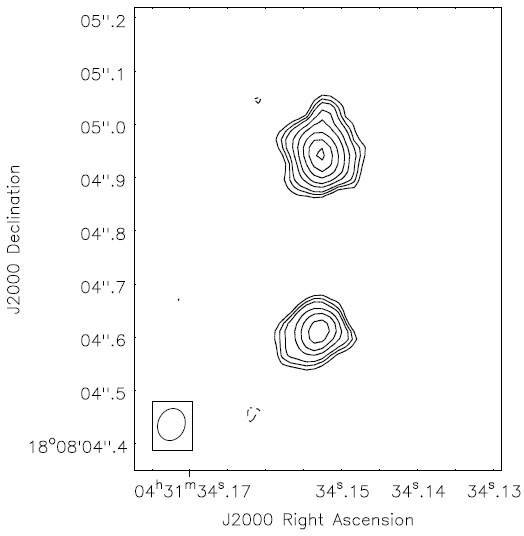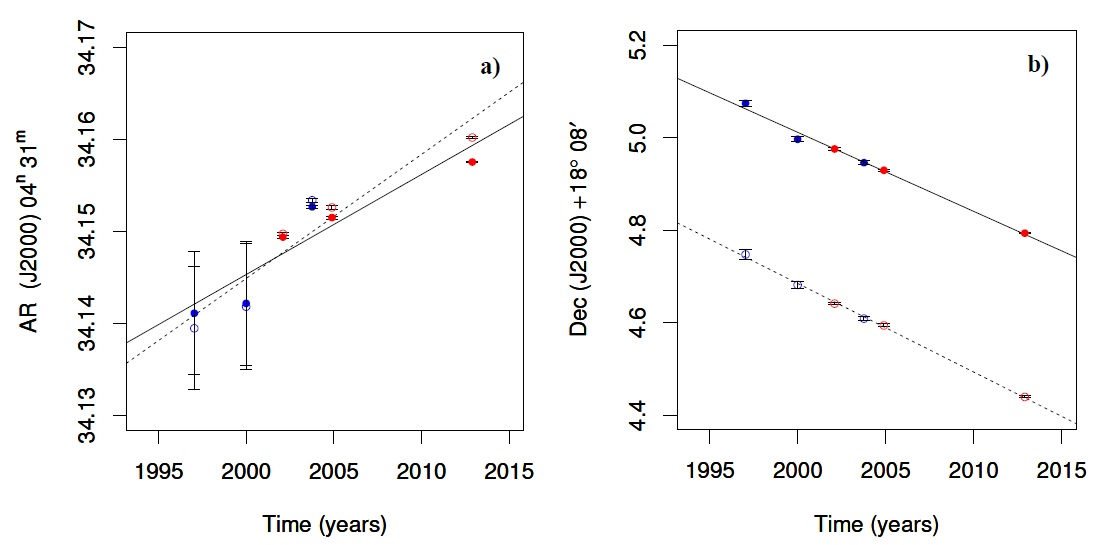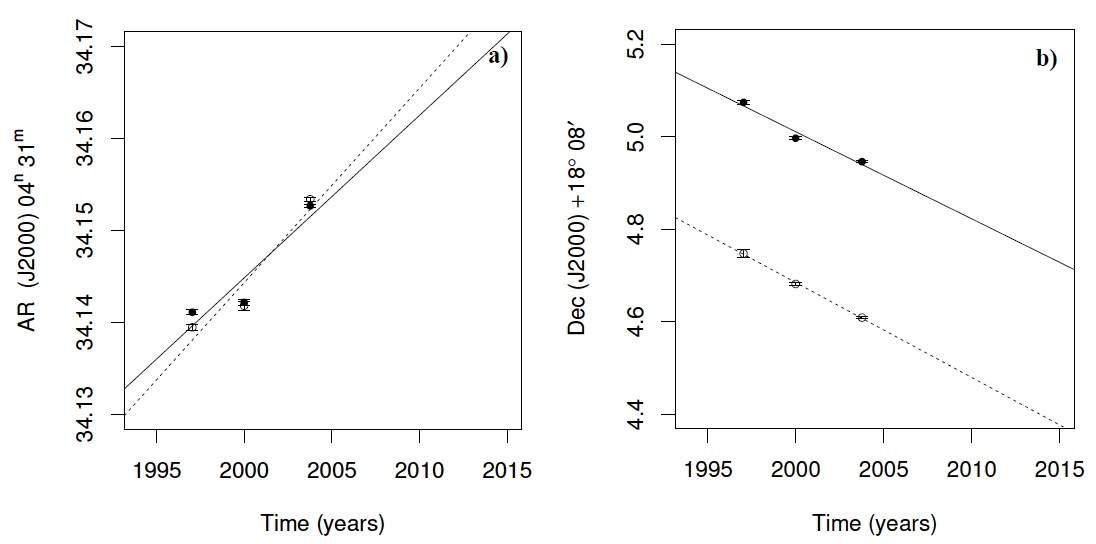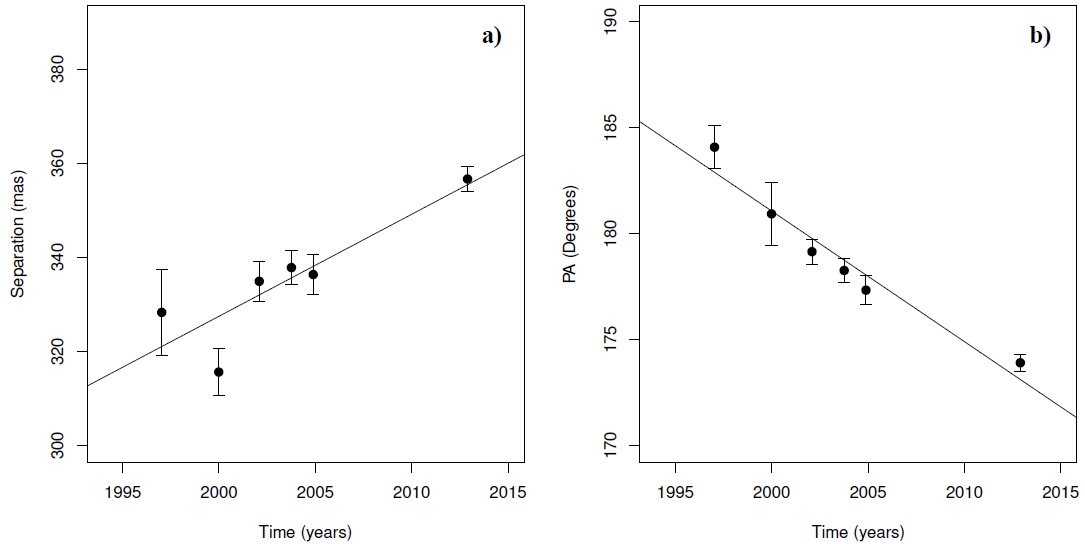1. INTRODUCTION
The formation of isolated low-mass stars within molecular clouds has been well studied. The accretion model proposed by Shu et al. (1987) has been successfully tested both theoretically and observationally. However, our understanding of the formation of binary and multiple stellar systems is still far from being succesfully modeled as is that of isolated low-mass stars. This is a really serious problem, since most stars are binaries or multiples.
The determination of proper motions has proven to be a powerful tool to study various physical processes in regions of star formation. For example, the proper motions of Herbig-Haro objects and molecular outflows have helped to improve our understanding of the earliest evolutionary stages of the formation of single stars (e.g. Frank et al. 2014). In this regard, it is known that protostars also show proper motions, which, for near stars are on the order of a few milli-arcseconds per year. In particular, the determination of absolute and relative proper motions of binary star systems allows us to study the kinematics of both components, which could help us understand the interaction between the binary system and its environment and thus to understand its formation process (e.g. Rodríguez 2004).
The dark cloud Lynds 1551 (L1551) is located at a distance of about 140 pc and hosts a very active star-forming region (e.g. Ungerechts & Thaddeus 1987). In L1551 is embedded the IRS5 source, which is the brightest of the cloud (40 L⊙) and a young stellar object (YSO) prototype. Moreover, L1551 IRS 5 is detected as a binary system at radio wavelengths (Bieging & Cohen 1985). In particular, using observations at 7 mm, Rodríguez et al. (1998) showed that the continuum emission stems from two compact protoplanetary disks, which are separated by about 0.3” (≈ 40 AU at a distance of 140 pc). It is also known that L1551 IRS 5 is the driving source of a molecular outflow (Snell et al. 1980).
Proper motion studies have already been performed in the direction of the L1551 IRS 5 binary system. For example, Rodríguez et al. (2003), Lim & Takakuwa (2006) and Lim et al. (2016) estimated proper motions of this system using VLA observations at 2 cm and, 2+0.7 cm, respectively. However, the emission of the circumstellar disks at a wavelength of 2 cm has an important free-free contribution and a minimal contribution from dust emission, which traces not only the emission of the circumstellar disks of L1551 IRS 5, but also that of extended thermal jets associated with the disks. Since the emission of the circumstellar disk comes from dust grains, and it more compact than the emission of the radio jets, the most appropriate VLA wavelength to study the continuum emission of the circumstellar disks, and so to determine their proper motions, is 7 mm.
In this paper we analyze six sets of VLA observations of the continuum emission at 7 mm covering a time span of 15 years to determine the absolute and relative proper motions of the circumstellar disks of the L1551 IRS 5 binary system. The relative proper motions calculated for the L1551 IRS 5 system are the most accurate up to date, and allow a good estimate of the total mass of the system and of its period.
This paper is organized as follows: in § 2 we describe the VLA archive observations; in § 3 we present the observational results. § 4 and 5, respectively, contain a discussion and summary.
2. THE VLA ARCHIVE DATA: OBSERVATIONS AND DATA REDUCTION
All observations used to estimate the proper motions of the L1551 IRS 5 binary system were taken from the VLA archive of the National Radio Astronomy Observatory (NRAO)1. In order to separate spatially the two components of the L151 IRS 5 and to avoid the contribution to the compact circumstellar disks of L1551 IRS 5 of free-free emission, we selected only observations carried out with the A and B configuration at a wavelength of 7 mm. In addition, to determine reliable positions for the two circumstellar disks of L1515 IRS 5, only data sets with sufficient sensitivity were selected (rms ≤ 0.2 mJy). Under these considerations, we found five data sets of the A configuration and one of the B configuration in the VLA archive, covering a time span of about 15 years, from 1997 March to 2012 November. All observations were performed in both left and right circular polarization with a bandwidth of 100 MHz. Information on the six data sets is given in Table 1.
Table 1 Observations from the VLA archive at 7 mm
| Set | Epoch | Project | Phase Calibrator (J2000) |
Beam Size (arsec) |
| 1 | 1997.03 | AR0277 | 0431+206 | 0.15×0.09; -1.4 |
| 2 | 1999.99 | AT0235 | 0431+206 | 0.16×0.12; -68.8 |
| 3 | 2002.09 | AT0269 | 0431+175 | 0.06×0.04; -21.1 |
| 4 | 2003.76 | AC0675 | 0431+206 | 0.06×0.05; -20.7 |
| 5 | 2004.89 | AC0743 | 0431+175 | 0.05×0.05; 40.8 |
| 6 | 2012.90 | 12B-091 | 0431+175 | 0.04×0.04; -14.5 |
All data sets were edited, calibrated and imaged using the software Common Astronomy Software Applications (CASA) and following standard techniques. In order to obtain the best radio continuum maps, we procured cleaned images of the field using severalROBUST parameters of the CASA task CLEAN. The phase calibrator and the synthesized beam size of the multiepoch continuum maps are given in Table 1. The positions of both circumstellar disks of the binary system L1515 IRS 5 were obtained with the task IMFIT of CASA, which applies a Gaussian fit to the image (see Table 2).
Table 2 Position of the two components of L1551 IRS 5
| Epoch | Component | R.A. (J2000) 04h 31m |
Dec. (J2000) 18◦ 08′ |
| 1997.03 | North | 34.1411 | 05.075 |
| South | 34.1395 | 04.748 | |
| 1999.99 | North | 34.1422 | 04.997 |
| South | 34.1418 | 04.682 | |
| 2002.09 | North | 34.1494 | 04.976 |
| South | 34.1498 | 04.641 | |
| 2003.76 | North | 34.1527 | 04.946 |
| South | 34.1534 | 04.609 | |
| 2004.89 | North | 34.1515 | 04.930 |
| South | 34.1526 | 04.594 | |
| 2012.90 | North | 34.1576 | 04.794 |
| South | 34.1602 | 04.439 |
3. RESULTS AND DISCUSSION
An example of a 7 mm continuum map of the L1551 IRS 5 binary system (epoch 2003.73) is shown in Figure 1, where the spatial position of both compact circumstellar disks is seen. Figure 2 shows the temporal evolution of the projected position of the two circumstellar disks (north and south components) over a time span of about 15 years. From this figure, it is evident that the two components have clearly shifted their spatial position over time. Unfortunately, the six observation epochs found in the VLA archive were not carried out using the same phase calibrator; three data sets used the 0431+206 phase calibrator (Sets 1, 2 and 4), while the remaining three used the 0431+175 phase calibrator (Sets 2, 5 and 6; see Table 1). Since the selected observations were obtained with two different phase calibrators, it would not be advisable to use all data sets simultaneously to determine the absolute proper motions of the two components of L1551 IRS 5. However, all data sets can be used to calculate relative proper motions.

Fig. 1 Continuum contour map of the cicumstellar disk of the L1551 IRS 5 binary system at 7 mm, at epoch 2003.73. Contours are -4, -3, 3, 4, 5, 7, 9, 12, 15 and 18 times 0.11 mJy beam−1, the rms noise of the map. The beam size is 0.06 × 0.05 (bottom left corner).

Fig. 2 Plot (right ascension, declination and time) of the temporal evolution of position of the compact circumstellar disks of the L1551 IRS 5 binary system over a time span of 15 years. Circles and squares indicate the position of the north and south component, respectively.
3.1. Absolute Proper Motions
Since two different phase calibrators were used for the six data sets of L1551 IRS 5 at 7 mm, we are not able to calculate a reliable value for the absolute proper motion of the system using all data sets. However, the six data sets cover a long time span and both components of the binary system are detected with a large signal-to-noise ratio. Therefore, we can try to estimate a very rough absolute proper motion for L1551 IRS 5 using all data sets by assuming that the positional error of the phase calibrators (as observed by the VLA) is very small. Under this assumption (and considering the positional uncertainty of the phase calibrators), we made a linear least-squares fit to the measured absolute positions of both components as a function of time using the six epochs. The results of these fits are shown in Figure 3 (see also Table 3). The absolute proper motion of the L1551 IRS 5 binary system is of the order of 25.1 mas yr−1 (µα = +17.4±4.0 mas yr−1, µδ = −18.2 ± 0.6 mas yr−1), which at a distance of 140 pc implies a velocity in the plane of the sky of ≈ 16.7 km s−1. Very similar absolute proper motions were obtained by Rodríguez et al. (2003).

Fig. 3 Absolute proper motions of the north (full circles) and south (empty circles) components of the L1551 IRS 5 binary system using all six data sets. Blue circles are observations with the phase calibrator 0431+206 and red circles with the phase calibrator 0431+175 (error bars include both the positional uncertainty of the target source and the phase calibrator). The temporal evolution of the right ascensions and declinations is shown in panels (a) and (b), respectively. Solid and dashed lines represent the least-squares fits. The color figure can be viewed online.
Table 3 Absolute proper motions of L1551 IRS 5
| Data | Component |
μ
α (mas yr−1) |
μ
δ (mas yr−1) |
| All data | North | +15.5±3.7 | −17.1 ± 0.8 |
| South | +19.2±3.9 | −19.2 ± 0.4 | |
| Subgroup 1 | North | +25.2±1.0 | −18.8 ± 2.0 |
| South | +30.0±1.0 | −20.6 ± 2.0 | |
| Subgroup 2 | North | +10.8±1.0 | −16.9 ± 2.0 |
| South | +13.7±1.0 | −18.8 ± 2.0 |
In order to analyze each subset of observations carried out with the same calibrator, we also performed a linear least-squares fit to the measured absolute positions of both components of L1551 IRS 5 as function of time for each subset. The absolute proper motion of the L1551 IRS 5 system, using data sets with the phase calibrator 0431+206 (Sets 1, 2 and 4), is of the order of 33.9 mas yr−1 (see Figure 4), implying a velocity in the plane of the sky of ≈ 22.6 km s−1. On the other hand, an absolute proper motion of about 21.7 mas yr−1 (≈ 14.5 km s−1; see Figure 5) is estimated for the L1551 IRS 5 binary system using the observations with the phase calibrator 0431+175 (Sets 2, 5 and 6). Although the estimated proper motion for each subset is slightly different, the mean of both values is very close to that estimated using all data sets.

Fig. 4 Absolute proper motions of the north (full circles) and south (empty circles) components of the L1551 IRS 5 binary system for Subgroup 1 (Data Sets 1, 2 and 4). The temporal evolution of the right ascensions and declinations is shown in panels (a) and (b), respectively. Solid and dashed lines represent the least-squares fits.
3.2. Relative Proper Motions
In order to perform a detailed study of the relative proper motions of the L1551 IRS 5 binary system, we used all six data sets of 7 mm observations. First, we took the spatial position of the north component (the most intense component of the system) as reference and then we measured the position of the south component (right ascension and declination) and calculated its projected separation for each observation epoch. Then, we measured the position angle between the north and south components of the binary system L1551 IRS 5. A threedimensional plot (projected separation, position angle and time) is shown in Figure 6, where the relative proper motions of the two circumstellar disks of the L1515 IRS 5 binary system are evident. This figure shows the change over time of the spatial separation between the north and south components, as well as the position angle, over a time span of about 15 years. A change in the projected separation between the two components is clearly observed, which is increasing with time, while the position angle is decreasing.

Fig. 6 Plot (separation, position angle and time) of the temporal evolution of the projected separation of the south component with respect to the north component, and position angle over a time span of 15 years for the L1551 IRS 5 binary system.
In order to calculate the relative proper motions, we made a linear least-squares fit to the measured projected separations and the position angles between both components as function of time, using all data sets. The results of these fits are shown in Figure 7 (see also Table 4). From the fits we found that the south component is separating at a rate of 2.2 ± 0.6 mas yr−1, while the position angle between the two components is changing at a rate of −0.6 ± 0.1 degree yr−1. Using the six data sets of 7 mm observations and considering a time span of 15 years, we estimated an average projected separation and position angle between the north and south components of about 335 ± 5 mas (47 ± 1 AU assuming a distance of 140 pc) and 180±1◦, respectively. Using these values and those obtained from the fits, we calculated a relative proper motion for the components of the binary system L1551 IRS 5 of the order of 4.2 mas yr−1, which is slightly larger than that estimated by Rodríguez et al. (2003), who used 2 cm observations. However, as it is known, the circumstellar disk emission is mainly produced by dust, and hence the 7 mm observations better trace this emission. Therefore, we think that the relative proper motion of the compact circumstellar disks of the L1551 IRS 5 binary system, as calculated using only 7 mm observations, is more accurate than that calculated using centimeter observations.

Fig. 7 Temporal evolution of the projected separation of the compact circumstellar disks of L1551 IRS 5 (panel α)) and position angle (panel b)). Solid lines represent the least-squares fits.
Table 4 Relative proper motions of L1551 IRS 5
| Epoch | ∆α (mas) |
∆δ (mas) |
Separation (mas) |
P.A. (deg) |
| 1997.03 | -23±6 | -327±9 | 328±9 | 184±1 |
| 1999.99 | -5±8 | -316±5 | 316±5 | 181±2 |
| 2002.09 | 5±4 | -335±5 | 335±5 | 179±1 |
| 2003.76 | 10±3 | -338±4 | 338±4 | 178±1 |
| 2004.89 | 16±4 | -336±4 | 336±4 | 177±1 |
| 2012.90 | 37±3 | -355±3 | 357±3 | 174±1 |
There is a point in the time versus separation plot that deviates from the fit in Figure 7. This point corresponds to the observation carried out with the B configuration of the VLA. Since the observations in this VLA configuration have lower angular resolution, the accuracy of the positions will be lower; in addition, these observations are sensitive to more extended structures, which could also affect the determination of the centroids of the circumstellar disks. These facts could indicate that observations with the A configuration could be the most appropriate for this type of analysis. However, this single point does not affect substantially the result of the fit; it only produces a very minimal change.
As it is known, the mass of a star is the most fundamental property, since it determines its evolution and lifetime. However, the determination of mass is one of the most difficult problems in astronomy. In particular, binary systems are one of the few cases where it is feasible to determine the total mass of the system. Considering that the L1551 IRS 5 binary system is gravitationally bound and follows a Keplerian motion we can estimate the total mass of the system. However, it is necessary to make some assumptions, namely that the orbital plane of the binary system and the plane of the disks are almost parallel (see Bate et al. 2000), the orbit of the system is circular and the observed velocity is approximately vreal/cosi, where i is the inclination angle of the disks. Studies performed toward L1551 IRS 5 have estimated an inclination angle of about 60◦ (e.g. Rodríguez et al. 1998; Chou et al. 2014). Under these assumptions, we estimate a total mass of the binary system of about 1.7±0.1 M⊙. In addition to the total mass, we can also estimate the orbital period of the components of the system using Kepler’s third law, which is about 246 ± 27 years. This estimated mass is consistent with results for T Tauri binary systems by Ghez et al. (1995) and Woitas et al. (2001), who estimated masses of about 1.7 and 2.0 M⊙, respectively.
4. SUMMARY
In this paper we have analyzed 7 mm multi-epoch observations of the L1551 IRS 5 binary system using six data sets of the VLA archive. Observations were carried out with the A (five sets) and B configurations, and cover a time span of about 15 years. Given that the millimeter emission of L1551 IRS 5 comes mainly from the two compact circumstellar disks, this wavelength allows a reliable calculation of the proper motions of the system.
We estimated an absolute proper motion of the L1551 IRS 5 binary system of the order of 25.1 mas yr−1 using all data. This value should be taken with care, since the observations were not performed with the same phase calibrator. However, this value is consistent with those reported by other authors. In addition, we found that the projected separation between the two compact circumstellar disks is increasing with time and its position angle is decreasing. We calculated a relative proper motion of 4.2 mas yr−1, which makes it possible to estimate the total mass and orbital period of the binary system. We obtained values of 1.7 M⊙ and 246 years, respectively.
We would like to thank our referee for the very useful report on our manuscript. M.A.T. acknowledges support from DAIP (Universidad de Guanajuato).











 nueva página del texto (beta)
nueva página del texto (beta)



